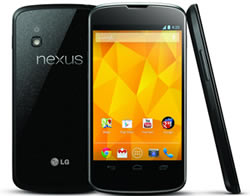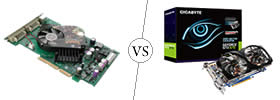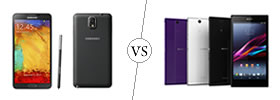Difference between Nexus 4 and HTC One X
Key difference: The Nexus 4 is Google's fourth Nexus-branded Android smartphone. It was produced in collaboration with LG Electronics. The phone runs on the Android 4.2 (Jelly Bean) operating system, which was launched with the phone. The HTC One X is a popular product of the HTC Corporation. It comes with Android v4.0 Ice Cream Sandwich and is upgradable to v4.1.1 Jelly Bean.
 With the constant upgrade in technology these days, new models of smartphones as well as upgraded models of smartphones with new features are being constantly launched in the market. Smartphones have become a way of life for many people, allowing them to do anything and everything on the go. This includes typing up a document, chatting with friends, video conferencing, writing up reports, checking e-mails, etc.
With the constant upgrade in technology these days, new models of smartphones as well as upgraded models of smartphones with new features are being constantly launched in the market. Smartphones have become a way of life for many people, allowing them to do anything and everything on the go. This includes typing up a document, chatting with friends, video conferencing, writing up reports, checking e-mails, etc.
One of the most popular operating systems for smartphones and tablets is Android. Android is a Linux-based operating system owned and operated by the Open Handset Alliance, a consortium of 84 leading firms, which includes mobile handset makers, application developers, some mobile carriers and chip makers. The consortium is lead in part by Google, as well as HTC, Sony, Dell, Intel, Motorola, Qualcomm, Texas Instruments, Samsung Electronics, LG Electronics, T-Mobile, Sprint Nextel, Nvidia, and Wind River Systems.
A number of these companies’ smartphones and tablets run on Android. Android is an open source software, which means that the code is freely available for modification and distribution by device manufacturers, wireless carriers and enthusiast developers. Among the number of various companies, Google has also launched its own line of smartphones based on Android, called the Google Nexus. Each device in the Nexus line is produced via collaboration between Google and a leading original equipment manufacturer (OEM) partner.
The Nexus devices in general have an advantage over other devices in that the Android in the Nexus devices is pure. I.e. the Android does not have any manufacturer or wireless carrier modifications to it, such as a custom graphical user interface. The Android also has an unlockable bootloader to allow further development and end-user modification, all of which is usually blocked on other Android smartphones.
The Nexus 4 and Nexus 7 are two of the devices available in the Google’s Nexus line. The main difference between them is the fact that the Nexus 7 is a 7 inch tablet, while the Nexus 4 is a smartphone. Also, the Nexus 7 pre-dates Nexus 4.
The Nexus 4 is Google's fourth Nexus-branded Android smartphone. It was produced in collaboration with LG Electronics. The phone features a 1.5 GHz quad-core Snapdragon S4 Pro processor, 2 GB of RAM, 8 or 16 GB of internal storage, front facing 1.3 megapixel camera and an 8 megapixel rear camera and a micro-SIM card tray. The phone runs on the Android 4.2 (Jelly Bean) operating system, which was launched with the phone. The phone also features a new camera technology, called the Photo Sphere. This allows one to take 360 deg Panorama shots.
 An OEM which also had Android based devices in the market is the HTC Corporation. The Taiwan-based company is considered one of the key players in the market of smartphones and tablets. One of its range of popular products are the HTC One Series. These included HTC One X, HTC One X+, HTC One V, etc. One of the most popular ones of these is the HTC One X.
An OEM which also had Android based devices in the market is the HTC Corporation. The Taiwan-based company is considered one of the key players in the market of smartphones and tablets. One of its range of popular products are the HTC One Series. These included HTC One X, HTC One X+, HTC One V, etc. One of the most popular ones of these is the HTC One X.
The HTC One X features a 4.7-inch super LCD 2 with 1280 x 720 (HD, 720p) and Corning Gorilla Glass. The HTC comes with Android v4.0 Ice Cream Sandwich and is upgradable to v4.1.1 Jelly Bean. When the HTC One X was launched it was the first phone to be offered with a quad-core processor among the HTC smart phones, making it the fastest HTC phone to date. It includes a 1.5 GHz, quad-core (global version) and 1.5 GHz, dual-core LTE version (USA and selected countries) along with ULP GeForce GPU and 1GB RAM. The phone is offered with non-expandable, 16 or 32 GB internal storage capacity. It offers an 8 megapixel camera with auto focus, smart LED flash, and BSI sensor, along with a 1.3 megapixe’, 720p secondary camera.
The information for the detailed table about the two phones has been taken from the HTC website, the Google Nexus website and GSMArena.com.
|
|
Nexus 4 |
HTC One X |
|
Launch Date |
November 13, 2012 |
May 2012 |
|
Company |
Google; designed in collaboration with and manufactured by LG Electronics. |
HTC Corporation |
|
Size |
133.9 x 68.7 x 9.1 mm (5.27 x 2.70 x 0.36 in) |
134.36 x 69.9 x 8.9 mm |
|
Display |
True HD IPS Plus capacitive touchscreen, 16M colors |
4.7-inch super LCD 2 |
|
Screen |
768 x 1280 pixels, 4.7 inches (~318 ppi pixel density) |
1280 x 720 (HD, 720p) |
|
Protection |
Corning Gorilla Glass 2 |
Corning Gorilla Glass |
|
Weight |
139g (4.90 oz) |
130 grams with battery |
|
2G Network |
GSM 850 / 900 / 1800 / 1900 |
HSPA/WCDMA: 850/900/1800/1900 MHz |
|
3G Network |
HSDPA 850 / 900 / 1700 / 1900 / 2100 |
GSM/GPRS/EDGE: 850/900/1900/2100 MHz |
|
GUI |
Pure Android |
HTC Sense 4.0 |
|
CPU speed |
Quad-core 1.5 GHz Krait |
1.5 GHz, quad-core (global version); 1.5 GHz, dual-core LTE version (USA and selected countries) |
|
GPU |
Adreno 320 |
ULP GeForce |
|
OS |
Android OS, v4.2 (Jelly Bean), upgradable to v4.2.2 (Jelly Bean) |
Android OS, v4.0 (Ice Cream Sandwich), upgradable to v4.1.1 (Jelly Bean) |
|
Chipset |
Qualcomm APQ8064 Snapdragon |
Nvidia Tegra 3 |
|
RAM |
2 GB RAM |
1GB |
|
SIM Size |
Micro-SIM |
microSIM |
|
Internal Memory |
8/16 GB storage |
16/32 GB |
|
Expandable Memory |
None |
No |
|
Sensors |
Accelerometer, gyro, proximity, compass, barometer |
Gyro sensor, G-Sensor, Digital compass, Proximity sensor, Ambient light sensor. |
|
Connectivity |
|
|
|
Data |
WiFi, NFC, GPRS, EDGE, USB |
GPRS, EDGE |
|
Speed |
DC-HSDPA, 42 Mbps; HSDPA, 21 Mbps; HSUPA, 5.76 Mbps |
HSDPA, 21 Mbps; HSUPA, 5.76 Mbps |
|
WLAN |
Wi-Fi 802.11 a/b/g/n, dual-band, DLNA, Wi-Fi hotspot |
Wi-Fi 802.11 a/b/g/n, Wi-Fi Direct, DLNA, Wi-Fi hotspot |
|
Bluetooth |
Bluetooth v4.0 with A2DP |
Bluetooth with aptX™ enabled (Bluetooth® 4.0) |
|
USB |
microUSB (SlimPort) v2.0 |
micro-USB 2.0. |
|
Primary Camera |
8 MP, 3264 x 2448 pixels, autofocus, LED flash |
8 megapixel camera with auto focus, smart LED flash, and BSI sensor. F2.0 aperture and 28mm lens |
|
Secondary Camera |
1.3 MP |
1.3 MP, 720p |
|
Video |
1080p@30fps |
1080p HD video recording, stereo sound rec., video stabilization |
|
Camera Features |
Touch focus, geo-tagging, face detection, photo sphere |
Capture a photo in the midst of recording HD video, Dedicated imaging chip, Continuous shooting mode, captures multiple snapshot, Auto flash smartly determined by distance from your subject, Video stabilization feature, High quality slow motion video capture and playback. |
|
Sound Enhancement |
SNS integration Active noise cancellation with dedicated mic |
Beats Audio |
|
Audio supported formats |
MP3/WAV/eAAC+/AC3 player |
Playback: .aac, .amr, .ogg, .m4a, .mid, .mp3, .wav, .wma (Windows Media Audio 9) Recording: .amr |
|
Video supported formats |
MP4/H.264/H.263 player |
Playback: .3gp, .3g2, .mp4, .wmv (Windows Media Video 9), .avi (MP4 ASP and MP3) Recording: .mp4 |
|
Battery Capacity |
Non-removable Li-Po 2100 mAh battery |
1800 mAh |
|
Available Colors |
Black |
Gray, White |
|
Messaging |
SMS(threaded view), MMS, Email, Push Mail, IM, RSS |
SMS (threaded view), MMS, Email, Push Email |
|
Browser |
HTML5 |
HTML, Adobe Flash |
|
Radio |
No |
Stereo FM radio with RDS |
|
GPS |
A-GPS support and GLONASS |
A-GPS support |
|
Java |
Java MIDP emulator |
Java MIDP emulator |
|
Additional Features |
|
|
Image Courtesy: blogs.computerworld.com, gsmarena.com









Add new comment